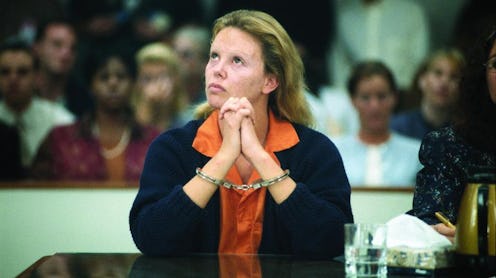
You guys already know (largely thanks to the Halloween season) that one of my weirder hobbies centers around creepy stuff: Reading and collecting weird and freaky stories, whether they're real, fictional, or somewhere in between. As such, it probably doesn't surprise you that I find this study about female serial killers fascinating, if also a little terrifying. Led by Marissa Harrison of Pennsylvania State University, it discovered the main difference between how female serial killers, or FSKs, and male serial killers operate — something which hitherto hasn't been examined.
Since most studies previously conducted about female serial killers have had relatively limited sample sizes, Harrison and her team sought to widen the frame and get a look at the bigger picture. According to the Washington Post, Harrison defined “serial killer” as “anyone who kills three or more people with a 'cooling-off period' of a week or more between each murder.” Using Murderpedia as starting point and mass media reports to verify their identified killers, the researchers examined the demographics, motives, methods, mental health, and victim characteristics for 64 FSKs operating in the U.S. between the years 1821 and 2008. According to the British Psychological Society's Research Digest blog, the total number of victims between all 64 FSKs was 311; on average, they killed six victims each.
Here's what the data revealed:
- The typical FSK is White, educated, married or previously married, attractive, and filed under the title of “Caregiver” in some way, shape or form: That is, they were a mother, a nurse, a nanny, or some other such role.
- Almost 40 percent of FSKs had some form of mental illness.
- The most common motive was financial gain, with “power-seeking” coming in a close second.
- The most common method was poison, although smothering, burning, choking, shooting, and bludgeoning were also used.
- The victims were frequently known to the killers, and often related to them — and therefore likely trusted them.
- Each FSK targeted at least one child, elderly person, or infirm person — that is, someone “who had little chance of fighting back.”
The fact that women primarily kill for power or money is of particular note. As Harrison put it to the Washington Post, “Female serial killers gather and male serial killers hunt. That was very interesting to me, as an evolutionary psychologist, that it reflects kind of ancestral tendencies.” It lines up, too, with what a 1995 study found about male serial killers — that is, that the majority of them sexually violate their victims. Evolutionarily speaking, women have traditionally behaved in such a way as to ensure their survival; men, on the other hand, operate on the principal that ensures the survival of their genetic code. So, when it comes to serial killers, it's perhaps unsurprising that women kill for resources, while men kill for sex.
So what do we do with this information, besides use it to keep ourselves up at night? I'll admit that I'm not entirely sure. Maybe we squirrel it away for whenever we need it — or we incorporate it into our daily “watch out” habits. The other thing that Harrison and her team found is that FSKs tend to get away with their crimes for a lot longer than male serial killers do; people apparently have a hard time believing these White, educated, attractive, caregiving people are capable of murder. I don't mean to make you paranoid or anything, but, well… not everyone is always what they seem.
Take, for example, these seven female serial killers, or these historical ones below:
1. Patty Cannon
The earliest FSK featured in the study's data set, Patty Cannon kidnapped slaves and free blacks in the early decades of the 19th century; she and her gang were indicted in 1822. In 1829, however, it was discovered that they had also killed at least four people: Three children including an infant and one adult male. It's unclear whether Cannon was convicted and sentenced to death; she ended up dying in her cell on May 11, 1829, though. Again, we're not totally sure how it went down, but it's believed she either died from natural causes or committed suicide by poisoning.
2. Jane Toppan
In 1901, Toppan, a nurse born as Honora Kelley and known as “Jolly Jane,” confessed to committing 31 murders; she did her patients in with poison. When she was finally caught, she won an insanity plea and was incarcerated in the Taunton Insane Hospital in Taunton, MA until her death in 1938.
3. Nannie Doss
Born Nancy Hazel in 1905, Nannie Doss killed 11 people between 1920 and 1954. Her primary motive was life insurance money; however, she later on said that she was “searching for the perfect mate, the real romance of life.” All in all, she poisoned four husbands, two children, her two sisters, her mother, one of her grandsons, and one of her mothers-in-law.
4. Delphine LaLaurie
You'll probably know this one from American Horror Story: Coven. A lot of the rumors of exactly what Delphine LaLaurie did to the slaves she kept in her New Orleans mansion in the 1800s may have been embellished over time; however, we do know that a fire in the residence in 1834 resulted in the discovery that she had been brutally torturing the slaves. Bodies were later discovered having been interred in the yard. It's believed that LaLaurie fled New Orleans after the truth about her came to light… although we're not totally sure. Records show that she died in Paris in 1849.
Images: Newmarket Films; Wiki Commons; Reading Tom/Flickr